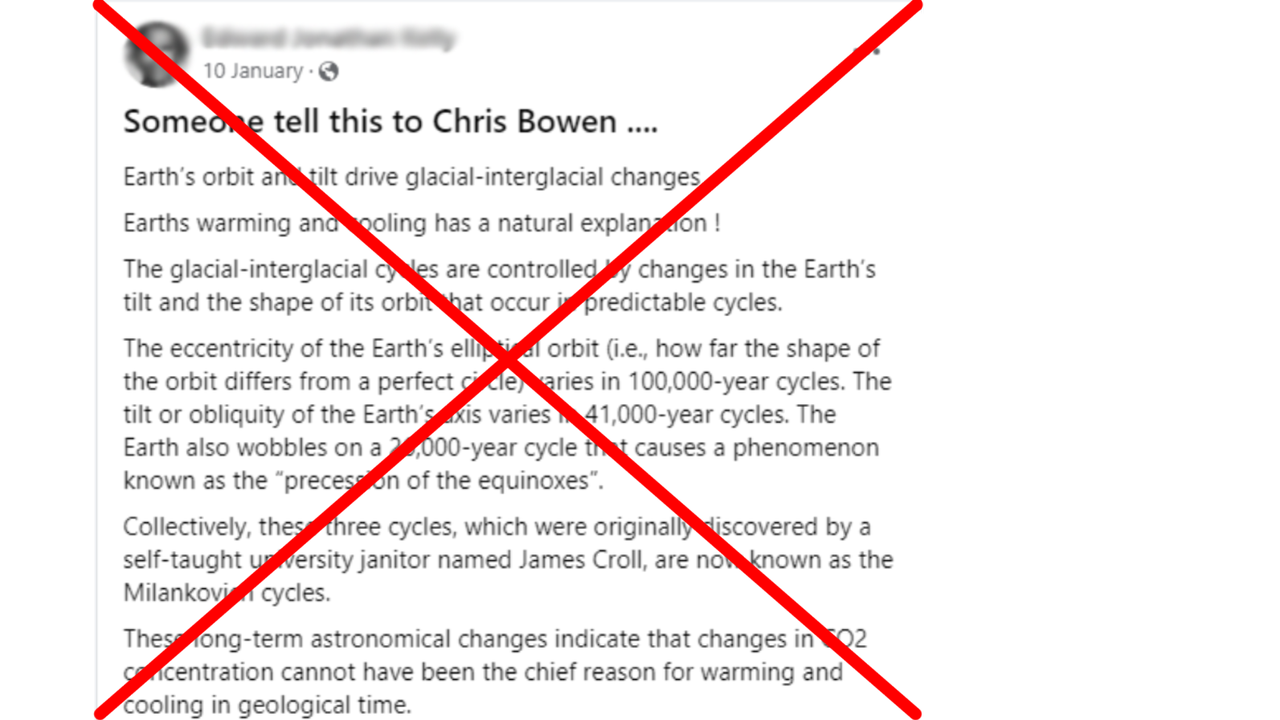WHAT WAS CLAIMED
The Milankovitch cycles are driving post-Industrial revolution global warming.
OUR VERDICT
False. The current rate of warming is faster than any Milankovitch change could produce.
Social media posts are claiming small, long-term shifts in the earth's orbit, known as Milankovitch cycles, are driving global warming rather than greenhouse gases.
The claims are false. Climate scientists say the Milankovitch cycles are a well-understood factor that can't account for the rise in global temperatures over the past 150 years.
"Someone tell this to Chris Bowen....Earths (sic) warming and cooling has a natural explanation," this Facebook post (archived here) states, with an explanation of the Milankovich cycles.
"Global Warming, indeed... HERE is PROOF it doesn't exist," this post, which accompanies a short video on the cycles, reads.
Various other posts make the same or similar claims, examples here, here, here and here.

Serbian scientist Milutin Milankovitch hypothesised in the early 20th century that long-term changes in the earth's tilt and position relative to the sun affected the planet's climate.
His theory, dubbed Milankovitch cycles, encompassed the shape of the earth's orbit (eccentricity); the angle of the earth's axis (obliquity); and where earth's axis of rotation is pointed, or its "wobble" (precession).
In this YouTube video, Dr Bradley Opdyke of ANU's Research School of Earth Sciences, explains that precession is a 20,000 year cycle, obliquity a 40,000 year cycle, and eccentricity a 100,000 year cycle.
NASA says the "small changes set in motion by Milankovitch cycles operate separately and together to influence earth's climate over very long timespans, leading to larger changes in our climate over tens of thousands to hundreds of thousands of years".
NASA also says Milankovitch cycles can't account for the rapid warming since the pre-industrial period.
"First, Milankovitch cycles operate on long time scales, ranging from tens of thousands to hundreds of thousands of years," NASA says.
"Second, Milankovitch cycles are just one factor that may contribute to climate change, both past and present.
"Even for Ice Age cycles, changes in the extent of ice sheets and atmospheric carbon dioxide have played important roles in driving the degree of temperature fluctuations over the last several million years."

NASA says scientists are confident earth's warming of more than 1C since 1850 "is primarily due to human activities - specifically, the direct input of carbon dioxide into Earth's atmosphere from burning fossil fuels".
Dr Opdyke told AAP FactCheck that before the industrial revolution, Milankovitch vectors were pushing us toward a cooler earth.
"Milankovitch-forced warmth reached its peak about ten thousand years ago and we had been cooling slowly ever since," Dr Opdyke said.
James Renwick, a professor of physical geography at Victoria University of Wellington, told AAP FactCheck the Milankovitch processes took effect over millennia and longer.
"The rate of current warming is way faster than any 'Milankovitch change' could produce," he said.
"These Milankovitch cycles are what drive the ice ages, tens of thousands of years of cooling, then a rapid warming (rapid being a few thousand years), a period of stability, then back to cooling. We are currently in the 'back to cooling' part of the story," he said.
Prof Renwick said the cycles result in a "subtle, gradual changing in the intensity of sunlight falling on the Earth".
"Those subtle changes are felt only if the greenhouse effect (from greenhouse gases) is weak enough. That is, carbon dioxide concentrations in the air need to be below about 300 parts per million (ppm) so that the Milankovitch effects can be felt," he said.
Prof Renwick said Milankovitch effects started showing about 2.6 million years ago, as CO2 levels fell, but for tens of millions of years prior CO2 was too high for them to register.
"Now, CO2 levels are above 400ppm and Milankovitch is again off the table," he said.
The Verdict
The claim that Milankovitch cycles are driving post-industrial revolution global warming is false.
NASA and other climate scientists have confirmed that Milankovitch effects impact over thousands of years and cannot explain rapid warming since the mid-19th century.
Scientists have also explained that Milankovitch climate effects are so subtle that the amount of greenhouse gases produced by humans post-industrial revolution negates any impact the cycles would have.
False – The claim is inaccurate.
AAP FactCheck is an accredited member of the International Fact-Checking Network. To keep up with our latest fact checks, follow us on Facebook, Twitter and Instagram.












